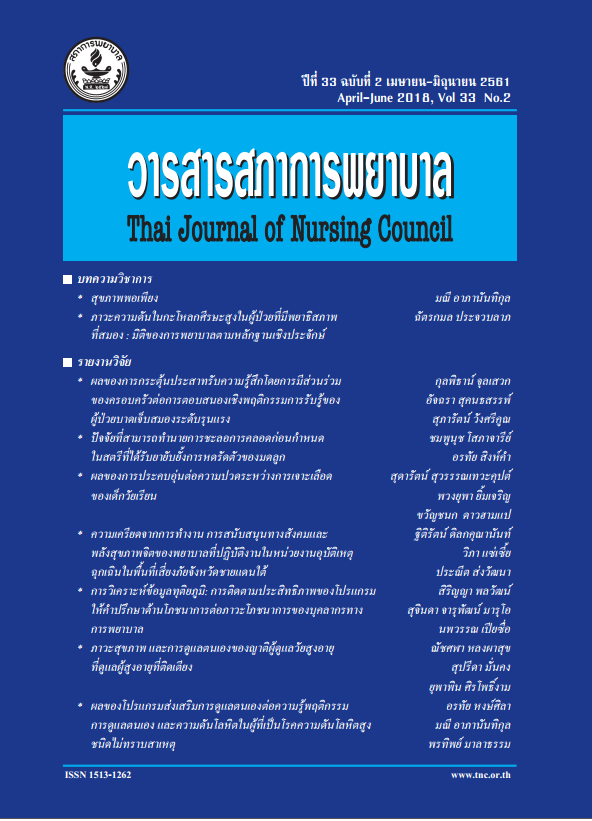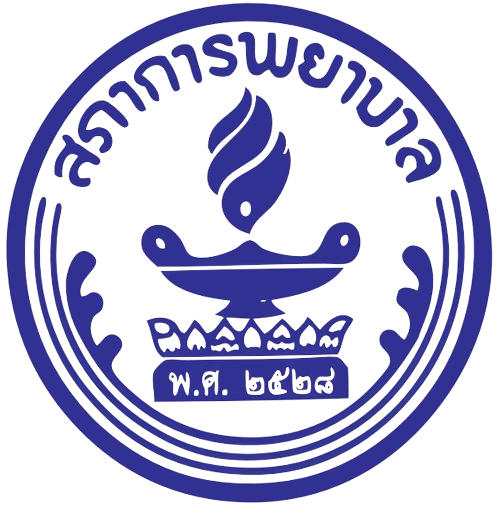Effect of Sensory Stimulation through Families’ Participation on CognitiveBehavioural Response of Patients with Severe Traumatic Brain Injuries
Keywords:
sensory stimulation, family participation, patient with severe traumatic brain injury, cognitive-behavioral responseAbstract
Abstract
Objective: To examine the effects that sensory stimulation through families’
participation could have on the cognitive-behavioural response of patients with severe TBI.
Design: One-group quasi-experimental research with a pre-test and a post-test.
Procedure: This study was conducted on 36 patients who were admitted to the
Neurosurgical Ward of Sakon Nakhon Hospital. The patients, selected by means of
purposive sampling, received sensory stimulation of 6 faculties, namely, vision, audition,
olfaction, gustation, tactility, and kinesthesia. The sensory stimulation was integrated
with the daily standard care provided by the researcher and the patients’ family members.
The research instruments consisted of (i) a sensory stimulation manual for the researcher;
(ii) a sensory stimulation manual for family members; and (iii) the Rancho Los Amigos
Scale (RLAS). The patients’ cognitive-behavioural response (CBR) was measured
using (i) the Glasgow Coma Scale (GCS); (ii) the Full Outline of Unresponsiveness
(FOUR) score; and (iii) the Revised Coma Recovery Scale (CRS-R). The data were
analysed using descriptive statistics and Wilcoxon Matched Pairs Signed-Ranks test.
Results: This study revealed that after receiving sensory stimulation through
family participation, the subjects displayed a statistically signifcant increase, by p < .001,
in their cognitive-behavioural response, the evidence being the increase in their scores
on GCS (from 7.14 ± 0.80 to 13.0 ± 1.82 [Z = -5.263, p = .000]), FOUR (from 7.33 ±
1.12 to 14.92 ± 1.56, [Z = -5.265, p = .000]), and CRS-R (from 4.47 ± 2.02 to
19.44 ± 4.06, [Z = -5.239, p = .000]), respectively.
Recommendations: It is suggested that nurses provide TBI patients with sensory
stimulation through family participation, by integrating it with daily standard care, in
order to improve and accelerate the patients’ cognitive recovery.
Downloads
References
1. Brain Trauma Foundation [BTF]. Guidelines for the management of severe traumatic brain injury 3rd edition.
J Neurotrauma 2007;24(1):S1-95.
2. Centers for Disease Control and Prevention (CDC).Traumatic brain injury & concussion. [serial online]. 2017 Jul [cited 2018 Apr 8]. Available from:https:// www.cdc.gov/traumaticbraininjury/data/index.html
3. Ministry of Public Health. Public health statistics A.D. 2015. Bangkok: Samcharoen Panich; 2016. (In Thai)45
4. Selassie AW, Zaloshnja E, Langlois JA, Miller T,Jones P, Steiner C. Incidence of long-term disability following traumatic brain injury hospitalization, United States, 2003. J Head Trauma Rehabil 2008; 23(2):123-31.
5. Sosnowski C, Ustik M. Early intervention: coma stimulation in the intensive care unit. J Neurosci Nurs 1994;26(6):336-41.
6. Padilla R, Domina A. Effectiveness of sensory stimulation to improve arousal and alertness of people in a coma or persistent vegetative state after traumatic brain injury: A systematic review. Am J Occup Ther 2016;70(3):1-8.
7. Teasdale G, Jennett B. Assessment of coma and impaired consciousness: a practical scale. Lancet 1974;304(7872):81-4.
8. Kinnunen KM, Greenwood R, Powell JH, Leech R, Hawkins PC, Bonnelle V, et al. White matter damage and cognitive impairment after traumatic brain injury. Brain 2011;134(2):449-63.
9. Megha M, Harpreet S, Nayeem Z. Effect of frequency of multimodal coma stimulation on the consciousness
levels of traumatic brain injury comatose patients. Brain Inj 2013;27(5):570-7.
10. Davis A, White J. Innovative sensory input for the comatose brain-injured patient. Crit Care Nurs Clin N Am 1995;7(2):351-61.
11. Meyer MJ, Megyesi J, Meythaler J, Murie-Fernandez M, Aubut JA, Foley N, et al. Acute management of acquired brain injury Part III: an evidence-based review of interventions used to promote arousal from coma. Brain Inj 2010;24(5):722-9.
12. Kaewsriwong S, Sukonthasarn A, Wangsrikhun S, Chanprasit C. Sensory stimulation process and cognitive function among persons with traumatic brain injury: a case study. Pacifc Rim Int J Nurs Res 2015;19(1):45-57.
13. Massuk N, Wongvatunyu S, Hanprasitkam K. Effectiveness of family caregiver participation in sensory stimulation program on traumatic brain injury patient’ recovery, bed-ridden complication, and caregiver’s satisfaction of care. Proceedings of the 13th Graduate Research Conference; 2012 Feb 17; Graduate School, Khon Kaen University; 2012.p.736-47. (In Thai)
14. Kuntirach N. The effects of sensory stimulation program on recovery outcome in severe head injury patients, [Master of Nursing Science Thesis in Adult Nursing]. Graduate School, Khon Kaen University; 2005. (In Thai)
15. Chaiwang S, Sukonthasarn A, Tungamnuay T. Effects of sensory stimulation on cognitive-behavioral responses of traumatic brain injured persons. Thai Journal of Nursing Council 2007;22(1):48-59.
(In Thai)
16. Urbenjaphol P, Jitpanya C, Khaoropthum S. Effects of the sensory stimulation program on recovery in unconscious patients with traumatic brain injury. J Neurosci Nurs 2009;41(3):E10-6.
17. Abbasi M, Mohammadi E, Sheaykh Rezayi A. Effect of a regular family visiting program as an affective, auditory, and tactile stimulation on the consciousness level of comatose patients with a head injury. Jap J Nurs Sci 2009;(1):21-6.
18. Parveen Y, Dhandapani M, Dhandapani S, Gupta SK. A randomized controlled trial to assess the effcacy
of auditory stimulation on selected parameters of comatose patients with traumatic brain injury. Indian J Neurotrauma 2015;12(02):128-34.
19. Wood R. Critical analysis of the concept of sensory stimulation for patients in vegetative states. Brain Inj 1991;5(4):401-9.46
20. Abbate C, Trimarchi PD, Basile I, Mazzucchi A, Devalle G. Sensory stimulation for patients with disorders
of consciousness: from stimulation to rehabilitation. Front Hum Neurosci 2014;8(616): 1-5.
21. Gray J, Grove SK, Sutherland S. Burns and Grove’s the practice of nursing research: appraisal, synthesis and generation of evidence. 8th ed. Missouri: Elsevier; 2017.
22. Wijdicks EF, Bamlet WR, Maramattom BV, Manno EM, McClelland RL. Validation of a new coma scale: the FOUR score. Ann Neurol 2005;58(4):585-93.
23. Giacino JT, Kalmar K, Whyte J. The JFK Coma Recovery Scale-Revised: measurement characteristics and diagnostic utility. Arch Phys Med Rehabil 2004; 85(12):2020-9.
24. Coma Science Group. Rancho Los Amigos - Revised Level of Cognitive Functioning. [serial online] 2016 [cited 2016 May 20]. Available from:https://www. coma.ulg.ac.be/images/levels_cogfunc.pdf
25. Li N, Yang Y, Glover DP, Zhang J, Saraswati M,Robertson C, et al. Evidence for impaired plasticity after traumatic brain injury in the developing brain. J Neurotrauma 2014;31(4):395-403.
26. Bao L, Chen D, Ding L, Ling W, Xu F. Fever burden is an independent predictor for prognosis of traumatic brain injury. PLoS ONE 2014;9(3):1-5.
27. Giuliani C, Peri A. Effects of hyponatremia on the brain. J Clin Med 2014;3(4):1163-75.








